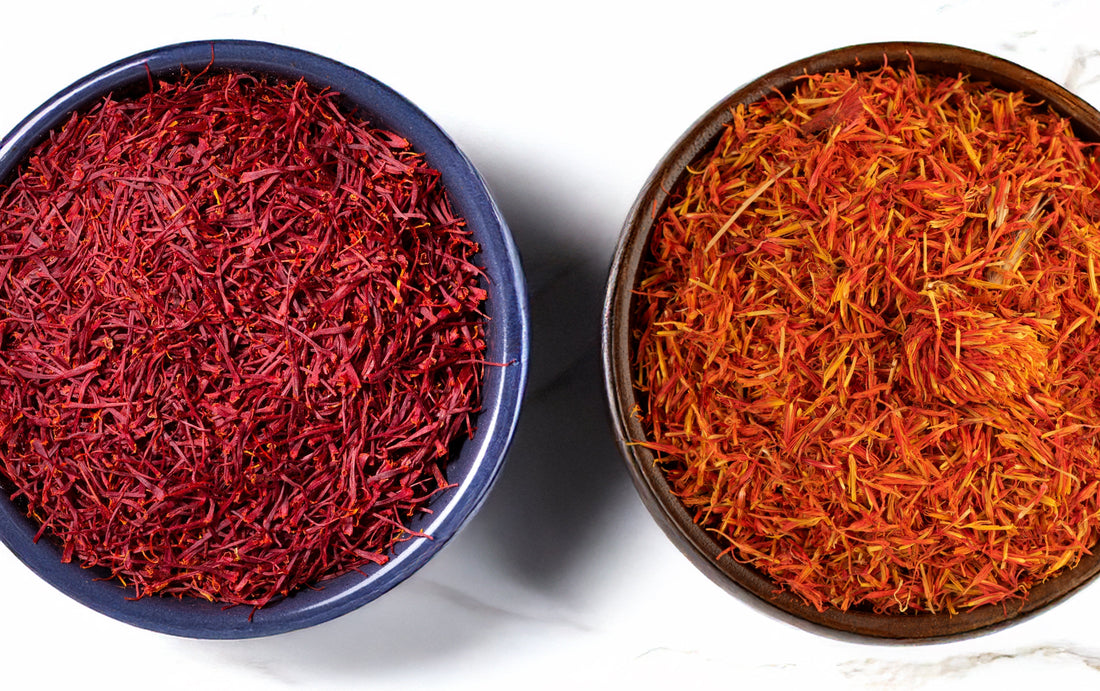
Real vs. fake: how to spot real saffron
Share
Saffron is often called "red gold" due to its high price, labor-intensive harvesting, and luxurious aroma. However, its high value also makes it one of the most counterfeited spices in the world. Whether you’re growing your own Crocus sativus or purchasing saffron from a store, knowing how to distinguish authentic saffron from fakes is crucial.
In this guide, we’ll walk you through how to spot real saffron, from the bulbs you plant to the threads in your kitchen.
1. The foundation: identifying genuine Crocus sativus bulbs
Before you even get to the saffron threads, choosing the right bulbs (corms) is step one. Here’s what to look for:
- Bulb appearance: Genuine Crocus sativus bulbs are round, slightly flattened, and have a papery outer layer. They range in size from 7 to 10 cm in circumference;
- Color and texture: They should be light brown with a firm feel—avoid soft or moldy bulbs;
- Root structure: If your bulb has fine white roots at the base, it's likely a healthy, real saffron bulb.
Red Flags: If a seller markets “seeds” for saffron, it’s a scam! Saffron is grown from corms, not seeds. Avoid bulbs labeled simply as “autumn crocus”—some ornamental crocuses look similar but do NOT produce edible saffron.
2. The bloom: recognizing a true saffron flower
Crocus sativus flowers bloom in autumn (September–November) and have three key characteristics:
- Petal color: True saffron crocus flowers are lavender to purple with delicate veins;
- Stigmas (threads): These are bright red, long, and slightly curled—the saffron spice itself;
- Filaments and anthers: The flower has yellow stamens (not used for saffron) and red stigmas.
Fake flowers and lookalikes: Be cautious of Colchicum autumnale (Autumn Crocus)—it looks similar but is toxic and does not produce saffron. Fake saffron is sometimes made using dried marigold or safflower petals, which may resemble saffron but lack its distinct aroma and properties.
3. The harvest: how to identify genuine saffron threads
When harvesting or purchasing saffron threads, check for these authenticity markers:
- Color: Real saffron threads are deep red with a slight orange hue at the tips;
- Three-part structure: Each saffron thread consists of a single, thin, trumpet-shaped filament with a bulbous tip;
-
Texture: Genuine saffron threads feel dry and slightly brittle, never soft or moist;
- Smell: Authentic saffron has a sweet, earthy aroma with hints of honey and hay;
- Taste: When placed on the tongue, real saffron has a subtle, slightly bitter-sweet taste, not just pure sweetness.
Common Fake Saffron Tricks:
Some vendors dye corn silk, safflower, or hibiscus red to pass it off as saffron. If the threads look too uniform, too moist, or unnaturally bright red, they may have been colored with artificial dyes.
Quick Test: Drop a few saffron threads in warm water or milk.
Real saffron releases a golden-yellow color after a few minutes, without dissolving or losing its red hue. Fake saffron (especially dyed imposters) will release color instantly and may even turn the water red.
4. Saffron powder vs. fake powder
Saffron is often sold as a powder, which makes it easier to fake. Here’s how to check:
- Color in water: Real saffron powder turns water yellow, not red;
- Aroma: It should have hints of honey, earth, and flowers—if it smells like turmeric or chili powder, it's likely fake;
- Price check: If the price seems too good to be true, it probably is!
Fake Powder Warning:
Some fake saffron powders are mixed with turmeric or paprika to mimic the color. Avoid overly bright orange or dull yellow powders—real saffron powder should be deep golden with red hues.
5. Where to buy authentic saffron
If you’re not growing your own, buying high-quality saffron from trusted sources is key.
- Look for saffron from Iran, Spain, India (Kashmir), or Greece;
- Certified Organic or ISO-Certified: Legitimate saffron brands have ISO 3632 certification, which tests purity;
- Price reality check:Genuine saffron costs $10–$30 per gram. If a deal seems too cheap, it’s probably fake.
Final thoughts: trust your senses!
Spotting real saffron from bulb to stigma to spice is easy if you know what to look for. Use these tips to ensure your saffron is authentic, pure, and worth the investment!
Have you ever come across fake saffron? Share your experience in the comments!
